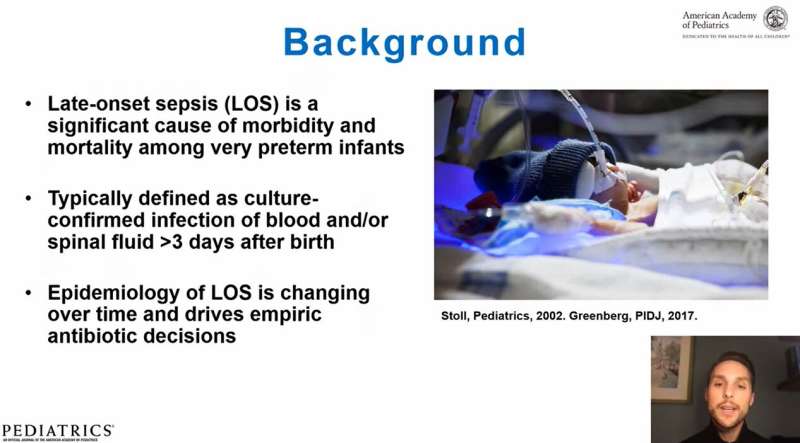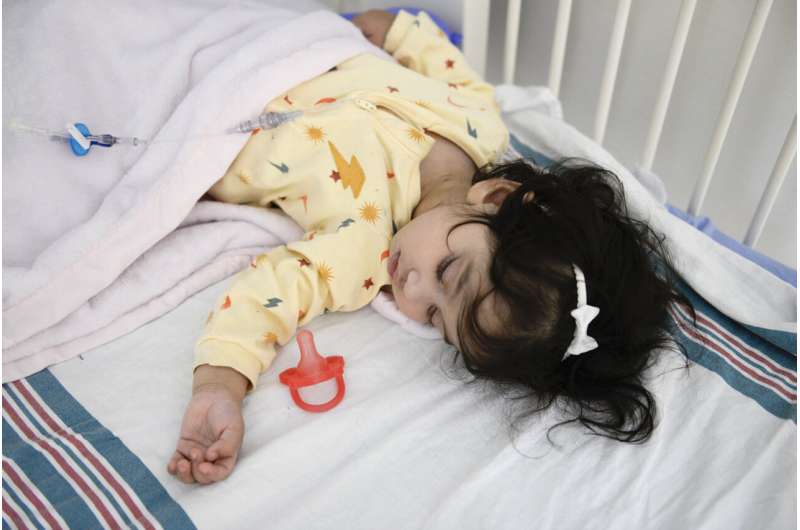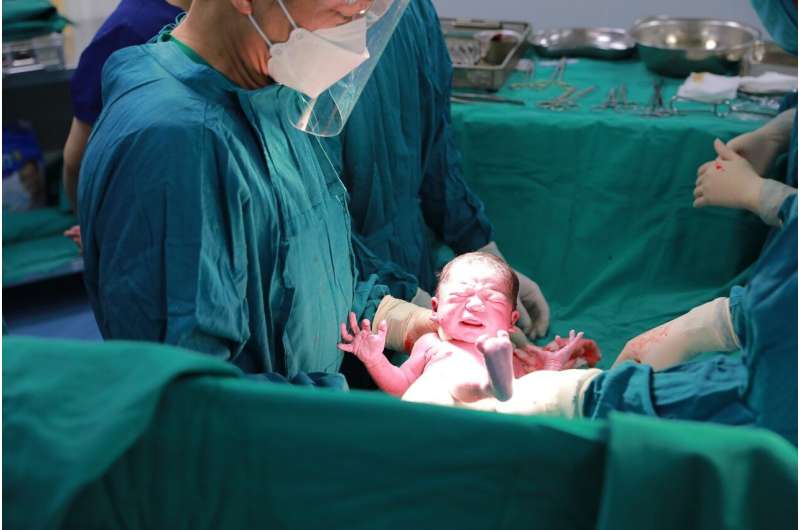Wednesday, November 16, 2022
Nutrient-enriched diets improve health of premature, underweight babies post-discharge

While smaller premature babies are given around-the-clock nutritional care in the Neonatal Intensive Care Unit (NICU), there has been debate among researchers on whether or not regular breastmilk or standard formula alone is enough nutrition for these babies to develop optimally after being discharged from the hospital.
Now, a meta-analysis—or detailed analysis of previous studies—conducted by researchers at the University of Missouri and University of Oxford, UK, suggests that adding nutritional fortification to human breastmilk or using a nutrient-enriched formula for those who are formula-fed, improves the size, weight and physical health of premature babies, as well as possibly improving their cognitive development.
Jan Sherman, a professor in the MU Sinclair School of Nursing, collaborated with Alan Lucas, a professor at University of Oxford, UK, to analyze more than 27 randomized trials that involved more 2,000 premature babies around the world, including in North America, Europe, Asia, and Africa. After comparing the physical and neurodevelopmental health outcomes, the researchers found that small premature babies who were given a nutrient-enriched diet after being discharged from the NICU weighed more, had larger heads and brains, and stronger bones. Although the research is incomplete, some evidence suggests that improving growth in these babies may also benefit cognitive development.
“This new research-based review can help providers decide on the best nutritional care for premature babies after they are discharged from the NICU,” Lucas said. “Breast feeding is the preferred way of feeding these babies, but whether they are breast or formula fed, we hope that this review will also help providers to appraise optimal levels of nutrients used for this important group of babies. It has also been questioned whether such nutrient-enriched diets would put these babies at potential risk of cardiovascular disease. However, the studies reviewed did not support this concern.”
Lucas has been researching nutrition in premature babies for 45 years, and Sherman, a Neonatal Nurse Practitioner (NNP) as well as an expert in statistical analysis, has seen the health issues babies born prematurely face first hand while working in NICUs for nearly 40 years.
“Every baby deserves the best possible care we can provide, and every parent wants the best outcome for their baby, so providing optimal nutrition is very important to us,” Sherman said. “The dietary choices that providers make for these infants is very important given that early nutrition is crucial for positive health outcomes later on in life.”
“Post-discharge nutrition in preterm infants” was recently published in NeoReviews, a journal published by the American Academy of Pediatrics.
14 th Edition of Pediatrics | 24-26 April 2023| london, United kingdom (Hybrid)
Sunday, November 13, 2022
Study shows nearly one-third of extremely premature infants develops late-onset sepsis

Nearly one-third of very premature infants develop late-onset sepsis, a life-threatening infection that occurs more than three days after birth, according to new research from Children’s Hospital of Philadelphia (CHOP), in collaboration with the Vermont Oxford Network. The study, published today in Pediatrics, also found that 1 in 2 infants born at 23 weeks or earlier either died and/or developed the infection.
“Late-onset sepsis is associated with a greater chance of death or, for those who survive, technology-dependent chronic illness,” said first author Dustin D. Flannery, DO, MSCE, an attending neonatologist at Children’s Hospital of Philadelphia and Assistant Professor of Pediatrics at the University of Pennsylvania.
The researchers analyzed a large national sample of very preterm infants born at Vermont Oxford Network centers. Infants who died in the first 3 days after birth were excluded from the study. Of 118,650 infants included in the study, 10,501 (8.9%) developed late-onset sepsis.
The researchers identified 34 pathogens causing late-onset sepsis, the most common being coagulase negative staphylococci (29%) and Staphylococcus aureus (23%). Infected infants were less likely to survive, and those who did had increased risks of requiring home oxygen, tracheostomy, and gastrostomy. One in 2 infants born 23 weeks or earlier either died later and/or developed the infection.
“These results shine a light on a current challenge in our field: despite successful, coordinated national prevention efforts, infection rates have plateaued in recent years,” Dr. Flannery said. “As resuscitation at the limit of viability increases, we must identify innovative ways to improve late-onset sepsis prevention in order to improve outcomes for these patients.”
International Conference on Pediatrics, Perinatology and Child Health
12th Edition of PPCH | 12-14 December 2022 | Dubai, United Arab Emirates (Hybrid) Visit: http://pediatrics.pencis.com #PediatricsConferences #Perinatology #childHealth
Friday, November 11, 2022
For Kids With Kidney Disease, Pediatric Expertise Is Key — But Not Always Close By

Jaxon Green, 6, was diagnosed with kidney disease the day he was born. His illness meant that for years his life would depend on daily dialysis. And because his family lives in Tamaqua, a rural Pennsylvania town, his diagnosis also meant taking frequent two-hour trips to Philadelphia to see the closest pediatric nephrologist — even though an adult dialysis center was just five minutes from their home.
Pediatric kidney care is not as simple as prescribing small doses of adult medication, said Dr. Sandra Amaral, the lead researcher for a study published by JAMA this month. It’s important for children with kidney disease — especially end-stage kidney disease, or ESKD — to receive specialized care, but pediatric nephrology is a niche field. On top of that, specialists are not spread out evenly across the country.
Amaral and her team of researchers sought to examine these geographic differences and their impact on kids who need dialysis — a blood-filtering treatment that takes over the role of the kidneys — and are waiting for transplants.
To do this, the researchers compared how long it took for children who received treatment at for-profit dialysis centers to reach certain milestones — for example, being placed on the waitlist for a kidney transplant — compared with children who received treatment at nonprofit dialysis centers. “We’re sort of using profit status a little bit as a surrogate for having access to pediatric expertise,” said Amaral, the medical director of the kidney transplant program at the Children’s Hospital of Philadelphia, or CHOP, where Jaxon receives treatment.
Specifically, nonprofit centers are usually in urban areas and part of major hospital systems, such as CHOP and the Johns Hopkins Hospital in Baltimore. For-profit dialysis centers are more likely to be stand-alone facilities, tend not to have pediatric specialists on staff, and serve more rural areas.
The retrospective study followed 13,333 children who began dialysis treatment between 2000 and 2018. Among its findings:
- Children treated at for-profit centers had about a 20% lower chance of being put on the kidney transplant waitlist compared with patients at nonprofit facilities.
- Children at for-profit facilities were about 30% less likely to receive a kidney transplant than patients at nonprofit facilities.
- Among both for-profit and nonprofit facilities, the chance of being put on the waitlist and the chance of receiving a transplant were lower for patients treated in free-standing facilities, meaning facilities not based in a hospital.
One factor behind the findings, Amaral said, is that many facilities are big dialysis chains that primarily serve adult patients and whose physicians are trained in adult medicine and lack pediatric expertise. “So I think that our pediatric patients may be falling through the cracks,” Amaral said.
Childhood end-stage kidney disease is rare. Fewer than 10,000 children in the U.S. have been diagnosed with ESKD, less than 1% of all people with the illness, according to data from the U.S. Renal Data System, part of the National Institutes of Health.
An editorial accompanying the study, written by Dr. Mary Leonard and Dr. Paul Grimm, both Stanford University physicians, explored why children who receive dialysis at nonprofits are being put on waitlists for transplants and getting them at a faster rate than children at for-profit centers. The difference, they wrote, “likely reflects greater clinician experience with the special needs of pediatric patients with ESKD and their families, as well as more robust facility-level processes and structures needed to care for these vulnerable patients.”
Receiving dialysis at nonprofits may make the process of being placed on the kidney transplant list smoother because the child is already plugged into a hospital system’s network, Amaral said. Pediatric nephrologists at nonprofits are usually connected to other departments in the hospital, including transplant teams that can help patients be in a better position for waitlist referrals. “For my patients on dialysis at CHOP with chronic kidney disease, we’re all kind of a one-stop shop,” Amaral said.
On the other hand, for-profit centers typically provide only dialysis care, so to initiate the process of getting a kid on a waitlist, they would have to reach out to other networks and transfer the child’s information. Amaral said this could be a lengthy and slow process.
The rate at which patients are referred for a transplant is one way to measure a dialysis facility’s quality of care, said Keisha Ray, an assistant professor at McGovern Medical School at UTHealth Houston, because centers play a major role in helping patients through the process. “They’re supposed to be the advocate; they’re supposed to be there for navigation purposes and administration purposes,” said Ray, who is not associated with the study.
The researchers also observed that children living in the Northeast were more likely than those in other areas of the country to receive dialysis care at a nonprofit facility.
Dr. Rita Swinford, director of pediatric nephrology at UTHealth Houston, considered this variable central to understanding why some children do not get on transplant lists as quickly as others. “It could be that they’re not close to transplant centers and access to care is key,” said Swinford, who is not affiliated with the study.
Nationwide, there is one pediatric nephrologist per 100,000 children, according to a 2020 report by the American Board of Pediatrics. They are most common in the Northeast. Montana, North Dakota, and Wyoming don’t have a pediatric nephrologist.
Three-year-old Nora Murphy, like Jaxon, was diagnosed with kidney disease the day she was born. Her mother, Jillian Murphy, knows well that the difference between treatment from for-profit dialysis centers and from nonprofits can be seen beyond numbers.
For roughly a year, Nora received dialysis at a for-profit center that was about an hour away. It was the closest facility to the small town in Connecticut where the family lived.
Later, Nora began getting her dialysis treatments at home, spending at least 12 hours every day “hooked to the machine,” Jillian Murphy said. The child typically did a lot of it overnight, when the Connecticut center wasn’t open. “So if there’s a problem with dialysis, it would happen overnight when there isn’t access to any dialysis-trained nurses,” Murphy said.
When problems occurred, like an infection, the family had to go to the hospital — nearly an hour away — that wasn’t well equipped with supplies or staff knowledgeable about pediatric kidney care. Murphy took to keeping a “go” bag holding dialysis equipment in case such a situation arose.
“I had to be ready to supply the hospital,” she said.
Last year, the family moved to Philadelphia to be closer to a children’s hospital.
KHN (Kaiser Health News) is a national newsroom that produces in-depth journalism about health issues. Together with Policy Analysis and Polling, KHN is one of the three major operating programs at KFF (Kaiser Family Foundation). KFF is an endowed nonprofit organization providing information on health issues to the nation.
International Conference on Pediatrics, Perinatology and Child Health
12th Edition of PPCH | 12-14 December 2022 | Dubai, United Arab Emirates (Hybrid) Visit: http://pediatrics.pencis.com #PediatricsConferences #Perinatology #childHealth
Rare, deadly genetic disease successfully treated in utero for first time

Using a protocol developed at UC San Francisco, physicians have successfully treated a fetus with a devastating genetic disorder for the first time, and the child is now thriving as a toddler, a case study in the New England Journal of Medicine reports.
“This treatment expands the repertoire of fetal therapies in a new direction,” said co-senior and corresponding author Tippi MacKenzie, MD, a pediatric surgeon at UCSF Benioff Children’s Hospitals, co-director of UCSF’s Center for Maternal-Fetal Precision Medicine and director of the Eli and Edythe Broad Center of Regeneration Medicine and Stem Cell Research. “As new treatments become available for children with genetic conditions, we are developing protocols to apply them before birth.”
The child’s disorder, infantile-onset Pompe disease, is one of several lysosomal storage diseases that begin to cause severe damage to major organs, such as the heart, before birth. By initiating enzyme replacement therapy during fetal development, physicians aimed for better outcomes than are typical with post-birth treatment—outcomes that can include death in early childhood, very low muscle tone or ventilator dependency.
After six prenatal enzyme replacement treatments at The Ottawa Hospital, the child, Ayla, was born at term. She is receiving postnatal enzyme therapy at CHEO (a pediatric hospital and research center in Ottawa, Canada), and doing well at 16 months of age. She has normal cardiac and motor function and is meeting developmental milestones.
“When we were having Ayla, we didn’t know if she’d be able to walk,” said Zahid Bashir, Ayla’s dad. “We didn’t know if she’d be able to talk. We didn’t know if she’d be able to eat. We didn’t know if she’d be able to laugh. So, as she hits each of these milestones, we continue to be amazed at her progress. So, yeah, it’s quite something, that I think sometimes we may take for granted, but most of the time we’re quite aware that she’s a miracle.”
A triumph of collaboration
The successful treatment is a feat of collaboration between UCSF, where an ongoing clinical trial on the treatment is based; CHEO and The Ottawa Hospital, where the patient was diagnosed and treated; and Duke University, home to the world’s top experts on Pompe disease.
“We really needed this multidisciplinary group of people to lend their deep expertise to all aspects of care,” said MacKenzie, who holds a Benioff UCSF Professorship in Children’s Health and a John G. Bowes Distinguished Professorship in Stem Cell and Tissue Biology. “Enzyme replacement therapy is a new frontier in the field of fetal therapy; it has been exciting to see it grow from a research project in my laboratory to impact the outcome for this family ultimately. UCSF is considered the birthplace of fetal surgery, and it is a special privilege for us to continue to expand the technologies and treatments available to help families facing a difficult diagnosis during pregnancy.”
Under usual circumstances, the patient’s family would have traveled to the UCSF Benioff Children’s Hospital Fetal Treatment Center to participate in the clinical trial. When COVID-19 restrictions made international travel unfeasible, experts from the two Canadian and two American hospitals met the family as a team by video to discuss alternatives. UCSF shared the treatment protocol with the team in Ottawa, where the family lives. Throughout the process, the entire team met weekly by video to discuss the health of the mother and fetus and to monitor the response to treatment.
“We have been treating our fetal patients using intrauterine therapy for more than 30 years,” said Karen Fung-Kee-Fung, MD, the family’s maternal-fetal medicine specialist at the Ottawa Hospital and professor of obstetrics and gynecology at the University of Ottawa. “The emergence of a new medical treatment to lift the burden of Pompe disease for this family, and potentially help other families affected by devastating genetic diseases, is both exciting and incredibly satisfying. We feel very privileged and honored to be a part of this international collaboration to help make this first-in-the-world treatment a reality.”
Pranesh Chakraborty, MD, a pediatrician and metabolic geneticist at CHEO and co-lead of the case study, has provided care to the family for years. “This treatment is very promising, and I am so happy for Ayla and her family,” said Chakraborty, who is also a researcher at the CHEO Research Institute and an associate professor at the University of Ottawa. “Having had the privilege and heartbreak of walking alongside families who have lost children to these devastating diseases, this work is very important to me.”
A big step forward for fetal therapy
Babies born with infantile-onset Pompe disease typically have enlarged hearts and die within two years if untreated. The disease is very rare, seen in less than 1/100,000 live births, and is caused by mutations in a gene that makes acid alpha-glucosidase, an enzyme that breaks down glycogen. Without it or with limited amounts, glycogen accumulates dangerously in the body.
“From our long-standing work at Duke treating patients with Pompe disease, we know first-hand the critical importance of earlier initiation of treatment,” said Jennifer Cohen, MD, co-lead author of the study and assistant professor in the Division of Medical Genetics in the Department of Pediatrics at Duke University School of Medicine. ”Our ability to offer a new treatment opportunity to this family and potentially change the course of this difficult disease has made this collaboration and project groundbreaking,” added Cohen.
Duke has played a pivotal role in many advances in the field of Pompe disease, including developing alglucosidase alfa as the first Food and Drug Administration-approved enzyme replacement therapy (ERT) for Pompe disease, identifying the role of high and sustained antibody titers to the ERT, using biomarkers to follow treatment response, and establishing immune tolerance induction protocols for the most severe patients, noted Priya Kishnani, MD, co-senior author, division chief of Medical Genetics at Duke University School of Medicine. ”All of these advances were crucial to this particular patient’s treatment and response,” said Kishnani. “The intrauterine therapy represents a new frontier for patients with Pompe disease.”
Pompe is one of eight lysosomal storage diseases that UCSF has received FDA approval to treat with enzyme replacement therapy in utero for a Phase 1 clinical trial of 10 patients. The other diseases are Mucopolysaccharidosis types 1, 2, 4a, 6 and 7, Gaucher disease types 2 and 3, and Wolman disease.
The researchers hope the success of this first application and publication of the case study will increase awareness of the UCSF clinical trial among parents at known risk of passing on these diseases and the physicians who treat them.
“Seeing how well Ayla is doing, it is important to pursue clinical trials to establish whether this kind of fetal therapy will be a good option for other families when treatment in the newborn period just isn’t early enough,” said Chakraborty, who directs the provincial program Newborn Screening Ontario based at CHEO. “We are working hard to try to improve access to this trial for other Canadian families.”
Two additional patients with different lysosomal diseases have now been enrolled in the UCSF clinical trial and both have completed their course of prenatal enzyme replacement therapy. The first patient gave birth in late October 2022, and the second will deliver in early November 2022. Both are doing well.
“It’s exciting to continue this research, which is an important step in the evolution of fetal therapy, from surgery for anatomic conditions to medical therapies for genetic conditions,” said MacKenzie.
International Conference on Pediatrics, Perinatology and Child Health
12th Edition of PPCH | 12-14 December 2022 | Dubai, United Arab Emirates (Hybrid) Visit: http://pediatrics.pencis.com #PediatricsConferences #Perinatology #childHealth
Wednesday, November 9, 2022
Umbilical cord milking may improve health in non-vigorous term and near-term infants

A treatment to move blood from the umbilical cord into an infant’s body may improve the overall health of newborns classified as non-vigorous—limp, pale and with minimal breathing, suggests a study funded by the National Institutes of Health. The procedure, known as umbilical cord milking, involves gently squeezing the cord between the thumb and forefinger and slowly pushing the blood into the abdomen. Compared to non-vigorous infants receiving the standard treatment of immediate umbilical cord clamping, infants who underwent cord milking were less likely to need heart and respiratory support, less likely to have a low level of oxygen in the brain, and more likely to have higher levels of hemoglobin, a substance indicating the presence of red blood cells.
The study was conducted by Anup C. Katheria, M.D., of Sharp Mary Birch Hospital for Women and Newborns in San Diego and colleagues at institutions in the United States, Canada and Poland. It appears in the American Journal of Obstetrics and Gynecology.
“The study results provide evidence that umbilical cord milking for non-vigorous term and near- term infants may be a safe, more effective alternative to immediate cord clamping,” said Michele Walsh, M.D., of NIH’s Eunice Kennedy Shriver National Institute of Child Health and Human Development (NICHD), which funded the study.
Standard practice for non-vigorous infants is to immediately clamp and cut the umbilical cord so that the infant can rapidly be resuscitated. Many researchers are concerned, however, that this could deprive them of needed blood and worsen their outcome. Non-vigorous infants are at risk for complications such as low oxygen levels in the brain, cerebral palsy and stroke. In the current study, authors sought to determine if cord milking for non-vigorous infants could provide similar benefits to delayed cord clamping in less time
The current recommendation for vigorous, full-term infants is to delay clamping and cutting the umbilical cord for at least 30 to 60 seconds after birth. This allows blood from the cord to enter the newborn’s circulation. Compared to infants undergoing immediate cord clamping, term infants undergoing delayed clamping have higher hemoglobin and iron levels. Preterm infants undergoing delayed cord clamping have less need for blood transfusion, are less likely to have a hemorrhage inside the brain, and are less likely to have necrotizing enterocolitis, a life-threatening deterioration of the intestine.
Non-vigorous infants in the study were assigned at random to undergo either cord milking or immediate clamping. For the cord milking, attending providers milked 20 centimeters of cord for two seconds, then repeated this procedure three times. Of more than 16,000 infants born after 35 to 42 weeks of pregnancy and screened at 10 institutions, 1,730 were included in the analysis.
For the study’s primary outcome—admission to a newborn intensive care unit—the researchers found no significant difference between the two groups. However, the researchers found several significant differences between the two groups for the study’s secondary outcomes. On average, the cord milking group had a higher hemoglobin level than the immediate clamping group. Of the milking group, 61% required heart and respiratory support, compared to 71% for the clamping group. Moderate to severe hypoxic ischemic encephalopathy—low blood oxygen levels in the brain—occurred in 1.5% of the milking group, compared to 3% of the clamping group.
International Conference on Pediatrics, Perinatology and Child Health
12th Edition of PPCH | 12-14 December 2022 | Dubai, United Arab Emirates (Hybrid) Visit: http://pediatrics.pencis.com #PediatricsConferences #Perinatology #childHealth
Monday, November 7, 2022
Infant head-shaping pillows are useless and dangerous to baby, FDA warns

Infant head-shaping pillows are not approved by the U.S. Food and Drug Administration and should not be used, the agency warned Thursday.
The pillows can create an unsafe sleep environment for infants, potentially contributing to the risk of suffocation and death.
Marketed as changing an infant’s head shape or symmetry or claiming to treat other medical conditions, they have no demonstrated benefit, the agency said in a news release.
“If you own an infant head-shaping pillow, throw it away; do not donate or give it to anyone else,” the alert said. “Be aware that infant head shaping pillows are not safe or effective for preventing or treating flat head syndrome or other medical conditions.”
In most cases, flat head syndrome will go away on its own as an infant grows up, the FDA said. It is not painful and it does not cause any developmental concerns. Using a head-shaping pillow may delay necessary medical evaluations and mask something more serious, such as craniosynostosis, where a developing infant’s skull bones join together too early.
The U.S. National Institutes of Health and the American Academy of Pediatrics both recommend infants sleep on their backs in a bare crib on a flat—not inclined—surface without pillows, toys, soft objects or loose bedding.
These recommendations are intended to help reduce the risk of Sudden Unexpected Infant Death (SUID), a category that includes Sudden Infant Death Syndrome (SIDS).
Health care providers should discourage the use of infant head-shaping pillows and educate their patients about the risks, the FDA added.
Infant head-shaping pillows are typically small, with an indent or hole in the center designed to cradle the back of an infant’s head while the infant lays face up.
Some do not have the indent and are rectangular-shaped.
The FDA has cleared caps, helmets or head bands to improve head symmetry or shape in infants and toddlers from 3 months to 18 months of age.
Some devices are also intended for infants from 3 to 18 months of age whose head shape has been surgically corrected, but who still have a moderate-to-severe flat head, the FDA said.
The agency said it has communicated its concerns about promotional materials to companies that make these pillows and will continue to monitor claims for these products.
International Conference on Pediatrics, Perinatology and Child Health
12th Edition of PPCH | 12-14 December 2022 | Dubai, United Arab Emirates (Hybrid) Visit: http://pediatrics.pencis.com #PediatricsConferences #Perinatology #childHealth
Monkeypox in kids, teens is rare and seldom severe: CDC

Out of the more than 25,000 U.S. cases of monkeypox reviewed in a new study, just 0.3% occurred in people under the age of 18, new government data shows.
Most of the kids and teens who contracted the virus—89%—”were not hospitalized, none received intensive care unit [ICU]-level care, and none died,” reported a team led by Ian Hennessee, with the Monkeypox Pediatric Working Group at the U.S. Centers for Disease Control and Prevention.
Since its global emergence earlier this year, monkeypox, which is typically confined to Africa, has infected tens of thousands of people worldwide.
The viral illness is characterized by painful lesions and typically requires skin-to-skin contact to spread. The vast majority of cases have occurred among gay and bisexual men.
Cases among children and adolescents have remained rare. In their analysis, the CDC team looked at 25,038 U.S. cases occurring between mid-May and late September.
Of those cases, only a tiny fraction—83, or 0.3%—occurred in people under the age of 18. Fifty-five of those cases were among adolescents aged 13 to 17, and another 28 occurred in kids up to age 12.
How did the younger kids contract monkeypox? According to Hennessee’s team, 20 cases occurring in kids under the age of 13 had enough data available to hazard a guess.
In 19 of those cases, kids “were exposed in the household setting; for 17 of these children, the reported exposure was direct skin-to-skin contact that routinely occurs between a child and an adult caregiver,” the researchers reported.
In the 20th case, it’s suspected that the child contracted monkeypox after using an item, such as a towel, previously used by an infected adult.
Among the 35 cases among adolescents with available data (32 of whom were males), it’s thought that sexual contact was the primary mode of transmission, the CDC team said. Investigations showed no sign that sexual abuse was involved in any of these cases.
Fortunately, none of the children or teens infected with monkeypox in the United States required ICU care, the team reported.
None of the kids under the age of 13 had monkeypox lesions in the anogenital area, and if lesions were present they occurred mainly on the torso, the researchers noted.
Two children under the age of 5 did contract monkeypox rash that involved lesions on their eyelids, while another older child also had eye issues related to monkeypox—all three were hospitalized and later released.
Among the 55 adolescents with monkeypox, lesions occurred in the anogenital area in about 60% of cases, the CDC team reported. They said six of the cases were so serious as to require hospitalization, typically for “pain management, treatment of secondary bacterial infections, and systemic symptoms with rash.”
As happens with adult cases of monkeypox, many of the affected kids and teens received tecovirimat (TPOXX) and other medications as treatment.
While rare, cases of monkeypox in kids can occur, so “adults with monkeypox who interact with children in the household setting should follow transmission prevention guidelines to prevent the spread of monkeypox,” Hennessee’s group said. That includes covering up any lesions to minimize the risk of skin-to-skin contact.
Sexually active teens, especially boys involved in male-to-male sex, should consider getting the Jynneos vaccine, which can prevent monkeypox infection, the researchers added.
International Conference on Pediatrics, Perinatology and Child Health
12th Edition of PPCH | 12-14 December 2022 | Dubai, United Arab Emirates (Hybrid) Visit: http://pediatrics.pencis.com #PediatricsConferences #Perinatology #childHealth
Saturday, November 5, 2022
Mothers’ recall of early childhood feeding guidance from health care providers is inconsistent

Health care providers (HCPs) usually conduct 14 wellness visits with children before the age of five, and are often a trusted source of information for mothers. A research article featured in the Journal of Nutrition Education and Behavior discusses mothers’ recollection of key feeding guidance recommendations that can affect children’s long-term health.
“Many studies have looked at the nutrition guidance shared by HCPs with the families of young children, but few studies have described what guidance parents recall receiving,” according to author Andrea McGowan, MPH, who was affiliated with the Division of Nutrition, Physical Activity, and Obesity, National Center for Chronic Disease Prevention and Health Promotion, Centers for Disease Control and Prevention, Atlanta, GA, at the time this study was conducted. “This study fills that gap by analyzing the specific topics mothers remember and what factors influenced that recall.”
Data for this analysis come from the 2017-2019 National Survey of Family Growth, conducted by the Centers for Disease Control and Prevention’s National Center for Health Statistics. Among the 6,141 women who participated in the study, 1,632 had a child aged six months to five years in their home at the time of the survey. These women were asked to recall their child’s HCP discussing when to introduce solid foods and guidance on the specific feeding topics referenced in “Bright Futures: Guidelines for Health Supervision of Infants, Children, and Adolescents” from the American Academy of Pediatrics.
The study asked questions related to offering foods with many different tastes and textures, not forcing a child to finish food or bottles, offering a variety of fruits and vegetables, limiting foods and drinks with added sugar, and limiting eating meals in front of the television or other electronics.
Lead investigator Andrea McGowan, MPH, discusses a new study that shows mothers’ recall of early childhood feeding guidance from health care providers is inconsistent. For example, less than 50% of mothers surveyed remembered advice from health care professionals to limit kids’ use of electronic devices during meals. Credit: Journal of Nutrition Education and Behavior
Among mothers who recalled their HCPs talking about the introduction of solid foods, 37% recalled being told to introduce solid food before six months, when the recommendation is to wait until about six months of age and not before four months. More than half of mothers recalled an HCP discussing between four and five topics on early feeding guidance, with 31% recalling only two or three topics.
Mothers with higher education levels or older mothers were more likely to recall these feeding discussions. Of the five nutrition topics, offering a variety of fruits and vegetables had the highest percentage of recall, while less than half of the mothers recalled the recommendation to limit meals in front of the television or other electronic devices.
“Pediatricians report spending an average of 18 minutes with children and their parents during wellness visits with many health topics covered during that limited time,” states McGowan. “Innovative strategies tailored to families’ needs might alleviate the HCP burden and could enhance parental recall, especially when messaging is culturally relevant and personalized.”
International Conference on Pediatrics, Perinatology and Child Health
12th Edition of PPCH | 12-14 December 2022 | Dubai, United Arab Emirates (Hybrid) Visit: http://pediatrics.pencis.com #PediatricsConferences #Perinatology #childHealth
New algorithms could improve pediatric tuberculosis diagnosis Tuberculosis stands as one of the leading causes of death among young people...

-
New algorithms could improve pediatric tuberculosis diagnosis Tuberculosis stands as one of the leading causes of death among young people...
-
International Research Awards on Pediatrics, Perinatology and Child Health February 22-25 , 2022 | Amsterdam, Netherland(W) Visit: https...
-
Prompt treatment for functional neurological disorder in children found to be highly effective Visual representation of the autonomic nerv...


